“Prof. Ferguson advises the UK and US governments, WHO and the EU on emerging infections and modelling.”
“New and Emerging Respiratory Virus Threats Advisory Group“
“The New and Emerging Respiratory Virus Threats Advisory Group (NERVTAG) advises the government on the threat posed by new and emerging respiratory viruses.”
Nervtag bios, as of Sept. 25, 2020
“Neil Ferguson is director of the MRC Centre for Outbreak Analysis and Modelling and the NIHR Health Protection Research Unit for Modelling Methodology. He uses mathematical and statistical models to investigate the processes shaping infectious disease pathogenesis, evolution and transmission. His recent work has focused on the use of models as contingency planning tools for emerging human infections (notably Ebola and pandemic influenza), bioterrorist threats and livestock outbreaks, though he also undertakes research on the dynamics and control of vector-borne diseases (dengue, yellow fever and malaria) and pathogen evolution. He was educated at Oxford University where he also undertook postdoctoral research, then held a readership at the University of Nottingham before moving to Imperial College. Professor Ferguson is a Senior Investigator of the National Institute of Health Research, a Fellow of the UK Academy of Medical Sciences and received an OBE [Order of the British Empire] for his work on the 2001 UK foot and mouth disease epidemic. Prof Ferguson advises the UK and US governments, WHO and the EU on emerging infections and modelling.”
Above, screen shot of Neil Ferguson bio at Nervtag.
Above, 4/12/20, “The full horrifying scale of the 2001 foot and mouth outbreak told by the Welsh farmers in the middle of it," walesonline.co.uk, Anna Lewis…Neil Ferguson’s 2001 computer models said the only option was slaughter. British establishment had its mind set on mass slaughter of millions of healthy animals.…“Lest We Forget,” John Brignell, 2004
……………………………….
Current Nervtag members are:
“Professor Peter Horby (Chair): University of Oxford
Professor Wendy Barclay: Imperial College London
Professor John Edmunds: London School of Hygiene and Tropical Medicine
Professor Neil Ferguson: Medical Research Council, Imperial College London
Professor Andrew Hayward: University College London
Dr Benjamin Killingley: University College London Hospital NHS Trust
Professor Wei Shen Lim: Nottingham University Hospitals NHS Trust
Dr Jim McMenamin: Health Protection Scotland
Professor Peter Openshaw: Imperial College London
Professor Malcolm Semple: University of Liverpool
Professor Robert Dingwall: Dingwall Enterprises Ltd. and Nottingham Trent University
Dr James Rubin: Kings College London
Dr Cariad Evans: Sheffield Teaching Hospitals NHS Foundation Trust
Dr Chloe Sellwood: Co-opted Member, NHS England
Professor Ian Brown: Co-opted Member, Animal and Plant Health Agency (APHA)”
NERVTAG: member biographies (PDF, 63.4KB, 5 pages)
……………………………………..
Added: Computer models have become a substitute for science which takes much longer and costs much more:
“Lest We Forget,” 2004, John Brignell, numberwatch.co.uk
“It is relevant at this point to comment on the touching faith that politicians and the media have in computer models. It is generally true to say that most large computer models are not worth the magnetic oxide they are written on, and I say that as one who has been computer modelling for well over 40 years. Often they are written in the glaring absence of knowledge of the fundamental interactions on which they ought to depend. A notorious case is the climate models that predicted catastrophic global warming, when almost nothing was known about the mechanisms that control the climate. In the case of FMD [Foot and Mouth Disease], they did not even know how the disease was carried. It could be on the wind, on the wheels of vehicles or the soles of boots, in the throats of human beings or any combination of these and others.
Computer modelling has a number of attractions for academics. It does not need the resources that experimental science demands; nor does it need the long hours of careful attention required for research by measurement. In just a few hours you can create a model, just a computer program, which is so complex that no outsider can hope to unravel it. You can build in many assumptions that might well be unjustifiable under independent examination. Furthermore,
the human unconscious is a mischievous influence that can produce the
desired results, even for those who are not deliberately cheating.
In the same few hours you can produce beautiful graphs and tables, the like of which would take months in experimental science, but which are so convincing to laymen and particularly politicians and bureaucrats. This is a point so important that it is worth an interlude of its own.”…
…………………………………
Added: A 2006 academic study criticised Ferguson’s 2001 models calling for urgent slaughter of millions of healthy animals as “not fit for purpose.” (page 9) The critique “also described a febrile atmosphere [in 2001]–reminiscent of recent weeks [in 2020]– and claimed that this allowed [government selected] mathematical modellers to shape government policy.”...
March 28, 2020, “Professor Neil Ferguson predicted Britain was on course to lose 250,000 lives during the coronavirus epidemic,” UK Telegraph
“His [Neil Ferguson’s] research is said to have convinced Prime Minister Boris Johnson and his advisors to introduce the lockdown.
However, it has now emerged that Ferguson has been criticised in the past for making predictions based on allegedly faulty assumptions which nevertheless shaped government strategies and impacted the UK economy.
He [Ferguson] was behind disputed research that sparked the mass culling of farm animals during the 2001 epidemic of foot and mouth disease, a crisis which cost the country billions of pounds….
Mr Ferguson’s [2001] foot and mouth disease (FMD) research has been the focus of two highly critical academic papers [one in 2006 and one in 2011 peer reviewed in Science] which identified allegedly problematic assumptions in his mathematical modelling.”…
…………………………………………
Added: Neil Ferguson’s unvalidated predictive models resulted in the brutal slaughter of millions of healthy animals:
From 2006 Abstract, Kitching, Thrusfield and Taylor:
“During the 2001 epidemic of FMD in the United Kingdom (UK), this approach [killing infected animals] was supplemented by a culling policy driven by unvalidated predictive models. The epidemic and its control resulted in the death of approximately ten million animals, public disgust with the magnitude of the slaughter….Page 6: “In fact, the epidemic peak preceded the start of pre-emptive contiguous culling.…It was carnage by computer’ (9, 84). This graphically exemplifies the isolation and abstraction of ‘armchair epidemiology’….(75)….Page 6: “Modelling and scientific method:” “The disparity between the course of the 2001 epidemic and the model predictions demands an explanation.The numerical output of models has an air of intellectual superiority…while also seeming entirely appropriate in a society where numbers can ‘…reassure by appearing to extend control, precision and knowledge beyond their real limits…wrong numbers, one might add, are worst of all because all numbers pose as true’ (11). Numbers, therefore, may convey an illusion of certainty and security that is not warranted (43);…A model constitutes a theory, and a predictive model is therefore only a theoretical projection.…The degree of confidence in the 2001 predictive models is therefore low because they were not widely tested, and their conclusions (e.g. that pre-emptive contiguous culling was necessary to control the epidemic) have been refuted….The key question for any model is whether decisions made with it are more correct than those made without it (17). However, the consequences of following the recommendations of these [2001] models were severe: economically, in terms of cost to the country; socially, in terms of misery and even suicides among those involved in the slaughter programme; and scientifically, in the abuse of predictive models, and their
possible ultimate adverse effects on disease control policy in the future.”…[Such as 2020].
Below, slaughter ordered by Neil Ferguson. The Queen was so delighted by Ferguson’s work that in 2002 she awarded him an OBE [Order of the British Empire] for his 2001 efforts. Since the US likes crimes against humanity, they hired Ferguson too, per Ferguson’s Nervtag bio: “Prof Ferguson advises the UK and US governments, WHO and the EU on emerging infections and modelling.”
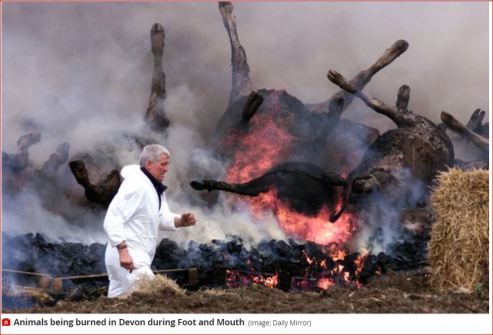
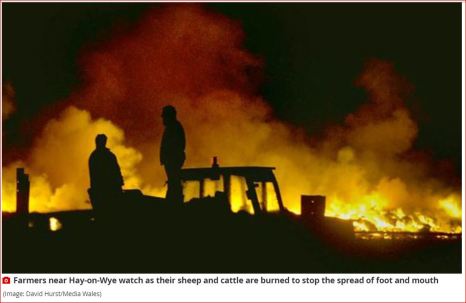 Two images above, April 12, 2020, “The full horrifying scale of the 2001 foot and mouth outbreak told by the Welsh farmers in the middle of it,“ walesonline.co.uk, Anna Lewis
Two images above, April 12, 2020, “The full horrifying scale of the 2001 foot and mouth outbreak told by the Welsh farmers in the middle of it,“ walesonline.co.uk, Anna Lewis
Image above, April 13, 2001, “Scientists back rapid slaughter policy,” BBC, “No alternative this time around, say scientists.”
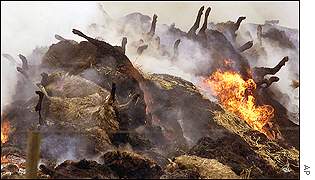
Image above, May 30, 2001, “100 days of Foot and Mouth,” BBC
Image above, 4/4/2001, “Animal disposal row intensifies,” BBC…[As someone said, “This time we’re the cattle.”]
……………………………………..



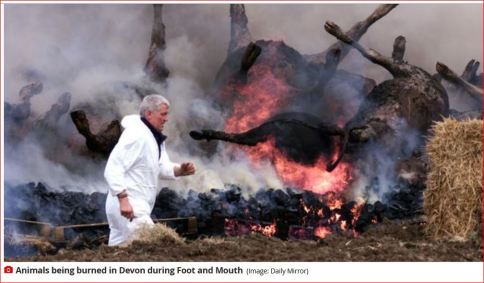
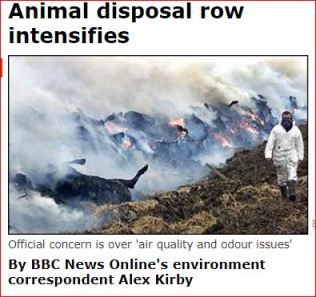

No comments:
Post a Comment